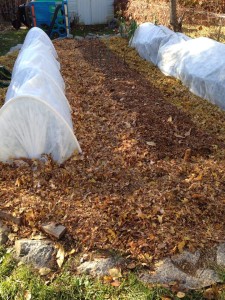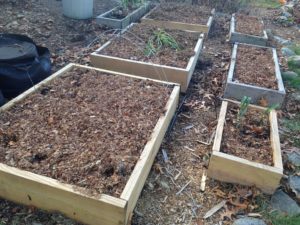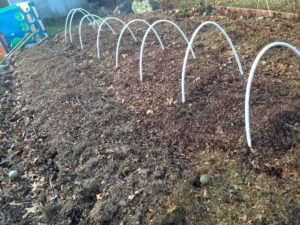
Shredded leaves keep soil in place, add nutrients to the soil and make a great, soft path material to keep weeds down. You can even alternate leaf-variety for patterns.
Cover crops are popular. People claim cover crops will add nitrogen to your soil (sometimes, sort of, but not much), they’ll protect the soil (kind of, sometimes) and prevent weeds (or they’ll act as weeds).
Let’s take a deeper look at this now that the end of the season is upon us.
The first thing to keep in mind is the size of your farm. Oh, you don’t live on a farm? Then you should consider the dimensions of your homestead. Huh? You don’t have one of those either?
You’ve got a typical urban/suburban sized garden of between 12 to 1000 sq ft? You should probably not bother with cover crops then, and here’s why: Cover crops are intended for limited circumstances, such as farms, where using a mulch isn’t cost-effective.
Purchasing cover crop seeds are cost effective for farms, but don’t establish or perform their preferred functions without work.
- You need to plan and sow them at the correct time, even if your garden is still in production. The latest possible date to sow cover crops is usually before I’ve pulled most of my garden, including my tomatoes.
- You need to irrigate the cover crops to help them establish.
- In the spring, you need to cut down most cover crops at the right time or they’ll reseed and act as weeds. This might mean you’re cutting them down while pollinators are still feeding on them.
- Depending on the crop, you may need to add other amendments (rhizobia) to get their full benefits.
- You’re probably still going to need to add nitrogen, even if you do everything right.
Fall leaves are great
Fall leaves on the other hand, are easy to find, easy to shred (use a lawn mower or power shredder), they stay in place all winter, they don’t suck nitrogen out of your soil, they protect the soil from compaction, feed the soil organisms that aerate the soil and add nitrogen, build organic matter, add nutrients, smother weeds, and more.
If you use shredded leaves, you’re going to want to add nitrogen in the spring.
The same thing is true if you use cover crops – you’re going to want to add nitrogen to your soil. If you’re going to want to add nitrogen to your soil regardless, why use cover crops?
Cover crops require attention, planning, water and time.
That required time may require you to cut your tomato harvest short in order to sow cover crops. I’m not willing to do that, are you?
I also don’t want to need to sow and irrigate cover crops, especially for so few benefits (outlined below). Instead, I’ll throw down some lime, spread some compost and cover everything with a few inches of shredded leaves on my own schedule and enjoy the season.
But imagine trying to source shredded leaves to cover 2-20,000 acres. Aint. Gonna. Happen. That’s why cover crops make sense for farms but not usually for home gardeners.
Let’s take a closer look at some of the reasons touted for using cover crops.
Cover crops add nitrogen to your soil!
This is true of leguminous cover crops (think clover), but the amount of nitrogen they add is limited. How limited? Limited enough that you’ll need to add another source of nitrogen to your garden for best results.
However, the rhizobia bacteria only fix enough N for it and the clover plant host. The fixed N does not leach freely into the soil and is not immediately available to the companion grass.
Source: U of AZ
So your clover and vetch add enough nitrogen to support your clover and vetch, but without much left over. That means you’ll need to add nitrogen for your tomatoes, cucumbers and peppers.
So if you’re going to add nitrogen anyway, why buy, sow, water cover crops in the fall?
Also, did you know that just growing leguminous crops doesn’t mean you’re fixing nitrogen? Yup, you can grow a field of clover and not get the nitrogen benefit if you don’t have the correct Rhizobia in your soil already! You can buy seed that is already inoculated but many people don’t know why it is necessary so they go with the less expensive, non-inoculated option, and therefore don’t get any nitrogen fixation.
Beware though, because not all nitrogen-fixing plants are the same. Some can be planted late in the season but all require at least four weeks of growth before the first hard frost, and some will come back hard next year. If they do come back and you decide to till the soil, guess what – your tilling has now allowed a lot of nitrogen to volatilize, and you’ve destroyed the tilth of your soil. (See “Cover Crops add Organic Material to the soil” below.)
But cover crops also “scavenge” nitrogen!
Some cover crops find available nitrogen in your soil and hold it, known as “scavenging.” Nitrogen scavenging isn’t a good enough reason for most of us to plant cover crops though, because:
- Nitrogen scavenging is usually meant for situations where farmers have added excess nitrogen, such as pouring on manure or otherwise adding too much nitrogen. These scavenging crops can help hold some of the excess N for the following season.
- These crops will find that nitrogen but they’ll then lose a lot of nitrogen once you cut the cover crop down. That means you’ll need to add more nitrogen to the soil anyway.
- You’re going to go through all this effort to scavenge N in your garden, which will largely be lost, when a bag of blood meal costs $10? Depending on your vendor, you’re likely to spend that much on the cover crop seed!
Then, of course, you’ve still got the issue of requiring time and irrigation to establish in the fall, requiring you cut them at the proper time so they don’t spread seeds, etc.
Cover crops prevent weeds from growing!
Cover crops can act as weed protection if they’re used as a “living mulch,” which is a great idea. (Some readers may recall that I use lettuce as a living mulch between onions and other locations until the crop needs the space.)
You need to mow these densely growing cover crops before they go to seed, which isn’t difficult, but because the crops also provide food for bees, people often don’t want to cut them too early, and some seed forms. If you don’t cut them down at the right time, then these crops will produce seed and then grow unwanted in your garden.
The crops that provide this protection also usually require longer periods of growth, sometimes needing to be planted mid to late summer. That typically doesn’t work for home growers who want to utilize our limited space as long as possible.
By contrast, shredded leaves will smother weeds, and the leaves aren’t going to grow.
Cover crops protect the soil from compaction!
That’s true, especially among the cover crops that need to be planted mid-season. Know what else protects the soil from compaction, but can be added later in the season, are free and don’t require irrigation? Shredded leaves!
Cover crops protect from runoff!
If you’ve got a suburban garden and you’re worried about runoff then you should probably reevaluate your use of soil amendments and/or the location of your garden. Oh, and you should use shredded leaves, because they also prevent soil and nutrient runoff.
Cover crops reduce surface crusting!
Okay. Any guesses what else does that?
Cover crops add organic material to the soil!
Well, maybe, but that depends on how you grow and kill your cover crops. If you kill and leave the material there to rot then yes, you’re adding some organic material to the soil, but it will be a slow process and will involve letting cut stems to sit on top of your garden until they finally decompose. This is also known as surface in situ composting, which allows lots of nitrogen to be lost.
If, however, you’re tilling it in, then you’re actually DESTROYING soil organic matter that burns off after tilling.
[T]illage destroys organic matter and increases soil erodibility, both critical aspects of soil fertility, water holding capacity, and general soil quality.
Source: NSCU
And
Excessive tillage:
Decreases organic matter
Reduces biological activity
Destroys aggregates
Reduces nutrient holding capacity
Restricts drainage
Diminishes pore space
Source: PennState Extension
You’re also raising weed seeds to the surface, destroying soil tilth which will facilitate nitrogen loss, and prevent the soil from holding moisture as well as it would otherwise.
Leaves, on the other hand, add lots of organic material to the soil, as does compost.
We’re down to two items that cover crops do better or at least faster than shredded leaves:
- Breaking hardpan:
Cover crops like tillage radish do a great job breaking up hard soils.Here’s the thing though: most urban/suburban gardens deal with hardpan by either replacing soil, or tilling and adding compost. The reasons are pretty simple – you can replace all of the soil in your typically-sized garden or simply lay a thick layer of compost on top and start growing immediately for cheap money. - Suppressing soil diseases and pests:
Some cover crops will effectively neutralize disease and pest issues for the following year’s crop. Leaves can’t do that.Choosing specific varieties of plants and various nematodes and fungicides, however, can.
Why do you hate cover crops?
If you’ve made it this far, you can be forgiven for thinking I hate cover crops or that I work for “big leaf” and I’m simply a shill for them.
The truth is that I think cover crops are great for their intended audience: Farmers and gardens of unusual size. For the typical home gardener, shredded leaves make much more sense, logically, ecologically, and financially.
Most importantly, if you’re going to use cover crops then you’ve hopefully got a full comprehension of what they will and won’t do, why, and your alternatives.




However, using leaves raises the possibility of moving jumping worms right into the garden!
Excellent critique of cover crops for small gardens! I’ve often grumbled (mostly to myself) about the same issues. I do a bit of cover cropping on my farm, but mostly leaves, leaves, leaves. Thanks!
Thanks! I’m glad you liked it!
Thanks for the feedback! My thinking was that shredded leaves will behave as non-shredded ones when the wind blows. Until now, I have been composting shredded leaves, but I will follow the advice and shred them directly into the garden.
Since I had so many field rats (or mice) this year, I am a bit concerned and wonder if you have seen them burrowing under the layer of leaves during the winter? I want to make sure that I don’t provide them with unnecessary protection.
Thank you!
Nikolay, bird netting held down with ground staples will also keep shredded leaves in place over a garden bed.
In a decade of use I’ve never had shredded leaves blow around very much, so I’m afraid I don’t have a good answer for you.
I try not to add more than 4″ of leaves and they’re shredded reasonably fine – about the size of a quarter. I don’t know if that makes the difference but larger pieces will obviously catch more wind and blow around more than smaller pieces.
The few pieces that do blow around are small enough to nestle in the grass rather than form a dense mat, so they don’t cause any problems.
If you wanted, you could probably use sheets of agribon (row cover) to hold the leaves in place, and that will still allow transpiration and rain/water to reach the soil, but I’ve never had to do that. Farms often need to get rid of large sheets of it at the end of the season, and it will have some rips, but it should do the job. Sorry I don’t have a better answer.
Shredded leaves are indeed a great nutritional and mulching source.
But, I have this question – winds in the fall can be quite strong and they blow away the shredded leaves. What is the strategy to keep them in place?